Questions with Answers, Solution | Numbers | Chapter 1 | 8th Maths - Exercise 1.3 (Properties of Rational Numbers) | 8th Maths : Chapter 1 : Numbers
Chapter: 8th Maths : Chapter 1 : Numbers
Exercise 1.3 (Properties of Rational Numbers)
Exercise 1.3
1. Verify the closure property for addition
and multiplication for the rational numbers −5/7 and 8/9 .
Solution:
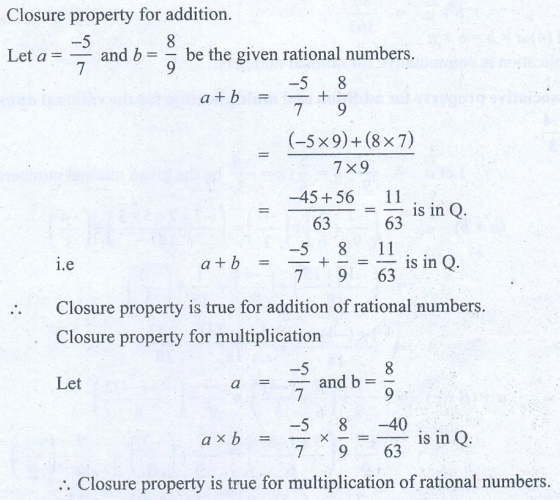
Closure property for addition.
Let a = −5/7 and b
= 8/9 be the given rational numbers.
a + b = −5/7 + 8/9
= [ (−5 × 9) + (8 × 7)] / [7 × 9]
= [−45 + 56] / 63 = 11 / 63
is in Q.
i.e a + b = [−5/7] + [8/9] = 11/63 is in Q.
∴ Closure property is true for addition of rational numbers.
Closure property for multiplication
Let a = −5/7 and b
= 8/9
a × b = −5/7 × 8/9 = −40/63 is
in Q.
∴ Closure property is true for multiplication of rational
numbers.
2. Verify the commutative property for
addition and multiplication for the rational numbers −10/11
and −8/33
Solution:
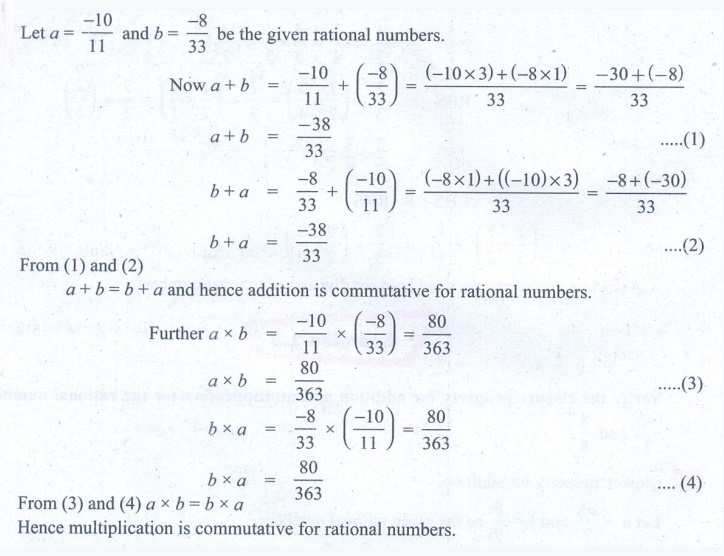
Let a = −10/11 and b = −8/33 be the given rational
numbers.
Now a + b = −10/11 + (−8/33) = [ (−10 × 3) + (−8 × 1)] /
33 = [−30 + (−8)] / 33
a + b = −38/33 ………….(1)
b + a =
(−8/33) + (−10/11) = [ (−8 × 1) + ((−10) × 3)] / 33 = [−8 + (−30)] / 33
b + a = − 38 / 33 …………..(2)
From (1) and (2)
a + b = b + a and hence addition
is commutative for rational numbers.
Further a × b = −10/11 × (−8/33) = 80/363
a × b = 80/363 …………….(3)
b × a = −8/33 × (−10/11) =
80/363
b × a = 80/363 ………….(4)
From (3) and (4) a × b = b × a
Hence multiplication is commutative for rational numbers.
3. Verify the associative property for
addition and multiplication for the rational numbers −7/9
, 5/6 and −4/3.
Solution:
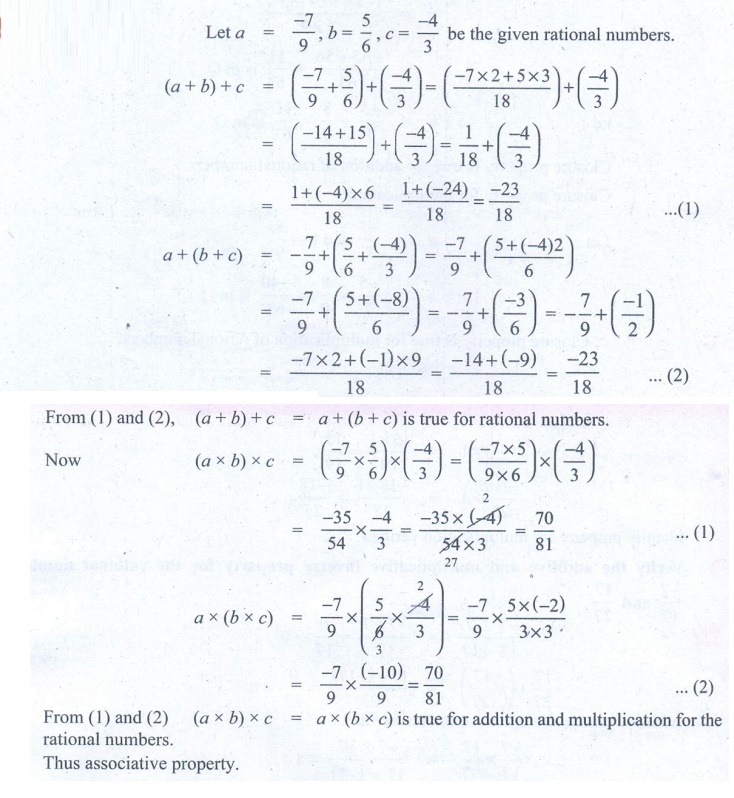
Let a = −7/9, b = 5/6, c = −4/3 be the given rational numbers.
(a + b) + c = (−7/9 + 5/6) + (−4/3) = ( [−7 × 2 + 5
× 3] / 18 ) + (−4/3)
= ( [−14 + 15] / 18) + (−4/3) = 1/18 + (−4/3)
= [1 + (−4) × 6] / 18 = [ 1 + (−24) ] / 18 = −23/18 ……..(1)
a + (b + c ) = −7/9 + (5/6 + (−4)/3) = −7/9 + ( [5 + (−4) 2] /
6)
= −7/9 + ( [5 + (−8)] / 6) = −7/9 + (−3/6) = −7/9 + (−1/2)
= [−7 × 2 + (−1) × 9] / 18 = [ −14 + (−9) ] / 18 = −23/18 ……..(2)
From (1) and (2), (a + b) + c = a + (b +
c) is true for rational numbers.
Now
(a × b) × c = (−7/9 × 5/6) × (−4/3) = ( [−7
× 5] / [9 × 6] ) × (−4/3)
= −35/54 × −4/3 = [−35 × (−4)] / [54 × 3] = 70/81 ………(1)
a × (b x c) = −7/9 × ([5/6]
× [−4/3]) = −7/9 × [5 × (−2)] / [3 × 3]
= −7/9 × (−10)/9 = 70/81
………(2)
From (1) and (2) (a × b) × c = a × (b
× c) is true for addition and multiplication for the rational numbers.
Thus associative property.
4. Verify the distributive property a × (b + c ) = ( a
× b ) + ( a
+ c) for the rational numbers a = -1/2 , b = 2/3 and c = -5/6 .
Solution:
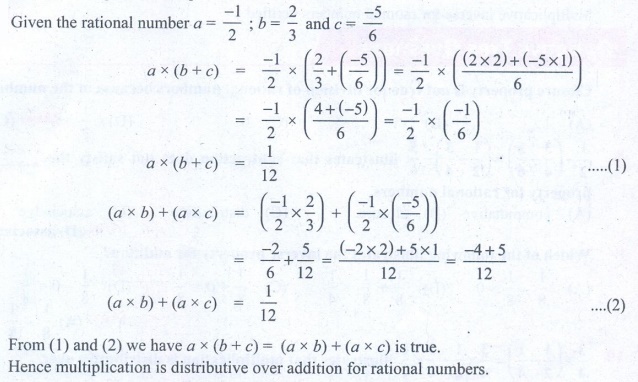
Given the rational number a = −1/2 ; b = 2/3 and c
= −5/6
a × (b + c) = −1/2 × (2/3
+ (−5/6)) = −1/2 × ( [(2 × 2) + (−5 × 1)] /6 )
= −1/2 × ( [4 + (−5)] / 6 ) = −1/2 × (−1/6)
a × (b + c) = 1/12
………(1)
(a × b) + (a
× c) = (−1/2 × 2/3) + ( −1/2 × (−5/6) )
= −2/6 + 5/12 = [(−2 × 2) + 5 × 1] / 12 = [−4 + 5] / 12
(a × b) + (a × c) = 1/12 ………(2)
From (1) and (2) we have a × (b + c) = (a × b) + (a × c)
is true.
Hence multiplication is distributive over addition for rational
numbers.
5. Verify the identity property for addition
and multiplication for the rational numbers 15/19 and −18/25.
Solution:
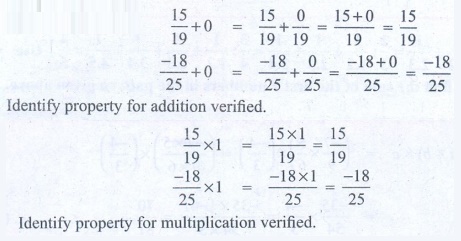
[15/19] + 0 = [15/19] + [0/19] = [15 + 0] / 19 = 15/19
[−18/25] + 0 = [−18/25] + [0/25] = [−18 + 0] / 25 = −18/25
Identify property for addition verified.
[15/19] × 1 = [15 × 1] / 19 = 15/19
[−18/25] × 1 = [−18 × 1] / 25 = −18/25
Identify property for multiplication verified.
6. Verify the additive and multiplicative
inverse property for the rational numbers −7/17 and 17/27.
Solution:
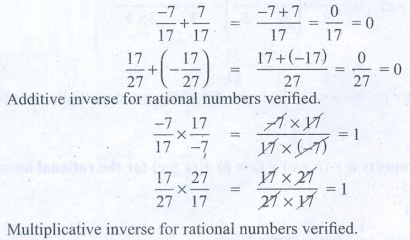
−7/17 + 7/17 = [−7 + 7] / 17 = 0/17 = 0
17/27 + (−17/27) = [17 + (−17)] / 27 = 0/27 = 0
Additive inverse for rational numbers verified.
−7/17 × 17/−7 = [−7 × 17] / [17 × (−7)] = 1
17/27 × 27/17 = [17 × 27] / [27 × 17] = 1
Multiplicative inverse for rational numbers verified.
Objective
Type Questions
7. Closure property is not true for division
of rational numbers because of the number
(A) 1
(B) –1
(C) 0
(D) 1/2
[Answer: (C) 0 ]
8.  illustrates that subtraction does not
satisfy the ________ property for rational numbers.
illustrates that subtraction does not
satisfy the ________ property for rational numbers.
(A) commutative
(B) closure
(C) distributive
(D) associative
[Answer: (D) associative]
9. Which of the following illustrates
the inverse property for addition?
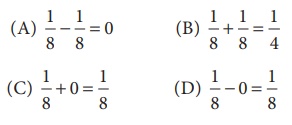
[Answer: (A) 1/8 – 1/8 = 0]
10.  illustrates
that multiplication is distributive over
illustrates
that multiplication is distributive over
(A) addition
(B) subtraction
(C) multiplication
(D) division
[Answer: (B) subtraction]
We know that different operations with the same pair of rational
numbers usually give different answers. Check the following calculations which are
some interesting exceptions in rational numbers.
(i) 13/4 + 13/9 = 13/4 × 13/9
(ii) 169/30 + 13/15 = 169/30 ÷ 13/15
Amazing …! Isn’t it? Try a few more like these, if possible.
Think
Observe that,
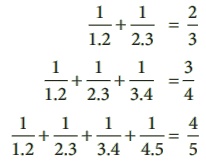
Use your reasoning skills, to find the sum of the first 7 numbers
in the pattern given above.
Solution:
1/1.2 + 1/2.3 + 1/3.4 + 1/4.5 + 1/5.6 + 1/ 6.7 + 1/7.8
= 7 / 8
Answer:
Exercise 1.3
Verify yourself for Qns 1 to 6.
7. (C) 0
8. (D) associative
9. (A) 1/8 – 1/8 = 0
10. (B) subtraction
Related Topics